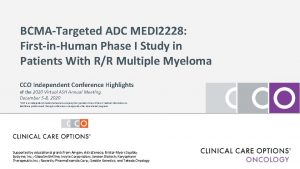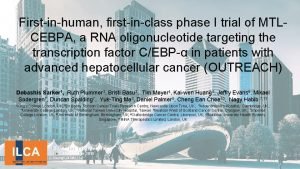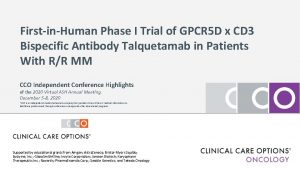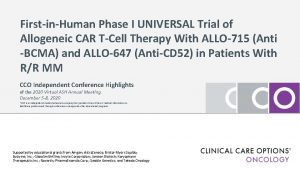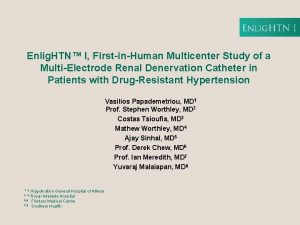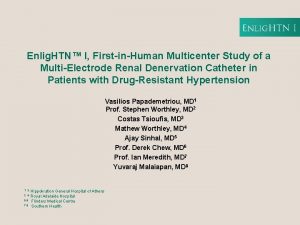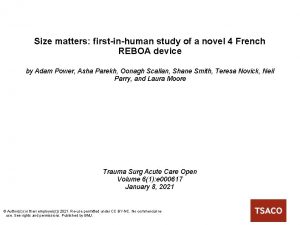Updated Results of a Phase I FirstinHuman Study










- Slides: 10

Updated Results of a Phase I First-in-Human Study of the BCL-2 Inhibitor ABT-199 (GDC-0199) in Patients with Relapsed/Refractory (R/R) Chronic Lymphocytic Leukemia (CLL)1, 2 Seymour JF et al. 1 Proc ICML 2013; Abstract 057. 2 Proc ASCO 2013; Abstract 7018.

Background Inhibition of the antiapoptotic protein BCL-2 shows promise for the treatment of CLL that is refractory to fludarabine (F) or CLL with 17 p deletion (Nat Med 2013; 19(2): 202 -8). l ABT-199 is an orally bioavailable, selective BCL-2 inhibitor with a greater than 500 -fold higher affinity for BCL-2 than for the antiapoptotic protein BCL-2 -like 1 (BCL-XL) (Nat Med 2013; 19(2): 202 -8). l Study objective: To determine the safety, pharmacokinetics, maximum tolerated dose, recommended Phase II dose and preliminary efficacy of ABT-199 in patients with relapsed or refractory CLL. l Seymour JF et al. Proc ICML 2013; Abstract 057; Proc ASCO 2013; Abstract 7018.

Phase I Dose-Escalation Trial Design Eligibility (n = 56) CLL relapsed/refractory to F or alkylator-based regimens No prior allogeneic or autologous stem cell transplant Cohort 1 dosing Cohorts 2 -8 Day -7 dose 50 mg† escalation Day -3 From week 1 day 1 200 mg* 200 mg qd Week 1 50 mg Week 2 150 mg‡ Week 3 and following Final dose * An initial dose of 100 mg was administered to 1 patient; † 3 patients (1 each in cohort 2 and 3, and 1 in cohort 5) received 20 mg of ABT-199 as the initial dose; ‡ Week 2 dose in cohorts 25 = 100 mg • After 3/3 patients in cohort 1 experienced dose-limiting tumor lysis syndrome, the initial dose was reduced and dosing was modified to include a stepped dose-escalation schedule. Seymour JF et al. Proc ASCO 2013; Abstract 7018.

Patient Demographics Characteristic Age, median (range) Males Prior lines of therapy, median (range) n = 56* 67 years (36 -86) 73% 4 (1 -10) F-refractory CLL 32% Del(17 p) mutation 38% Diagnosis (CLL/SLL) 49/7 * As of April 2013, 56 patients were enrolled and 40 were active in the study. Seymour JF et al. Proc ICML 2013; Abstract 057; Proc ASCO 2013; Abstract 7018.

Best Responses All evaluable patients (n = 55)* Overall response rate 84% Complete response (CR) CR/incomplete marrow recovery Partial response 11% 7% 65% Stable disease 7% Disease progression 2% One patient had not reached week 6 for evaluation by scan; 4 patients discontinued prior to assessment at week 6. * • 30/30 patients had a >50% reduction in lymphocyte counts from baseline. • 45/51 patients experienced a >50% reduction in nodal size from baseline by CT scan. - Median time to 50% reduction = 43 days • 27 patients had a >50% reduction in bone marrow infiltrate from baseline. Seymour JF et al. Proc ASCO 2013; Abstract 7018.

Best Responses in Evaluable Patients with High-Risk CLL with del(17 p) n = 16* Overall response rate 81% Complete response (CR) 6% CR/incomplete marrow recovery 6% Partial response 69% Stable disease 6% Disease progression 6% Fludarabine-refractory CLL n = 18† Overall response rate 78% CR/incomplete marrow recovery 17% Partial response 61% Stable disease * One patient had not reached week 6 for evaluation by scan; discontinued prior to week 6 assessment. Seymour JF et al. Proc ASCO 2013; Abstract 7018. 6% † 3 patients

Select Adverse Events Event All grades Grade 3 or 4 Diarrhea 41% 2% Neutropenia 39% 38% Upper respiratory tract infection 27% 2% Thrombocytopenia 18% 11% Pyrexia 14% 2% Anemia 13% 7% Hyperglycemia 11% 9% Tumor lysis syndrome* 11% * Includes 3 events from cohort 1; 2 clinical events and 1 laboratory event with the new dosing schedule Seymour JF et al. Proc ASCO 2013; Abstract 7018.

Tumor Lysis Syndrome (TLS) ABT-199 has antitumor activity in patients with relapsed/refractory CLL who have bulky disease. l TLS occurred in all 3 patients in cohort 1. l With the revised dosing regimen, clinical TLS occurred in 2 patients (1 with acute renal failure and 1 death) who had bulky lymphadenopathy (≥ 10 cm). l Key proposed study changes: – Further modify the dosing scheme to use a lower starting dose and then reduce dose-escalation increments. – Enhance current prophylaxis measures and monitoring for all patients. l Seymour JF et al. Proc ASCO 2013; Abstract 7018.

Author Conclusions Single-agent ABT-199 demonstrated activity in patients with relapsed/refractory CLL, including those with del(17 p) and fludarabine-refractory disease. l TLS can be associated with rapid tumor reduction. – A titrated dosing scheme combined with more aggressive prophylaxis, monitoring and management may provide adequate protection for patients. l ABT-199 warrants further single-agent and combination trials in CLL. l A Phase II single-agent study and a Phase III combination study in CLL are planned to start in late 2013/early 2014. l Seymour JF et al. Proc ASCO 2013; Abstract 7018.

Investigator Commentary: Results of a Phase I Trial of ABT-199 in Relapsed or Refractory CLL ABT-199 is a small-molecule oral inhibitor of BCL-2, a protein that is overexpressed in many B-cell malignancies. ABT-199 has a high affinity for BCL-2 but leaves other BCL-2 family members relatively intact, such as BCL-XL. One problem with previous BCL-2 inhibitors was thrombocytopenia. More selective agents like ABT-199 seem to have taken care of this issue. Single-agent ABT-199 appears to be remarkably active in CLL/SLL. In this Phase I study, the overall response rate was 84%. The response rate was similar in the high-risk population, such as patients with del(17 p) or fludarabine-refractory CLL, to that in the overall population. ABT-199 was well tolerated. The major side effects were nausea and diarrhea. These side effects can be easily managed, sometimes with supportive care alone or by small dose reductions. One of the challenges with ABT-199 is that it’s so active that some cases of tumor lysis syndrome have arisen, so the study had to use a stepped-up dose-escalation strategy, in which you start therapy with a baby dose and careful monitoring for a few days, after which a gradually higher dose can be used. This might take 2 to 3 weeks to build up to the target dose, which for CLL appears to be 400 mg daily. I believe ABT-199 will be a "home-run" drug in CLL/SLL. Interview with Brad S Kahl, MD, September 10, 2013
 Rpms phase
Rpms phase The symbol tsfa in alu operations include
The symbol tsfa in alu operations include Normal phase vs reverse phase chromatography
Normal phase vs reverse phase chromatography Hplc reverse phase vs normal phase
Hplc reverse phase vs normal phase Mobile phase and stationary phase
Mobile phase and stationary phase Stationary phase and mobile phase in hplc
Stationary phase and mobile phase in hplc Normal phase vs reverse phase chromatography
Normal phase vs reverse phase chromatography Difference between phase voltage and line voltage
Difference between phase voltage and line voltage Which detector used in hplc
Which detector used in hplc Phase to phase voltage
Phase to phase voltage Csce 441
Csce 441











